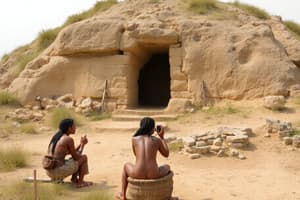Podcast
Questions and Answers
What is a characteristic of the social organization of hunter-gatherer groups during the Paleolithic Era?
What is a characteristic of the social organization of hunter-gatherer groups during the Paleolithic Era?
- Small groups of 20-50 people, often consisting of extended family members (correct)
- Large groups of over 100 people, with a complex system of governance
- No social organization, with individuals living in isolation
- A strict social hierarchy with a strong leader
What was a reason why hunter-gatherer groups moved from one place to another?
What was a reason why hunter-gatherer groups moved from one place to another?
- To wage war against other groups
- To follow a specific leader or spiritual guide
- To establish trade routes with other groups
- To find better living conditions, such as more abundant resources or favorable climate (correct)
What was a food gathering technique used by hunter-gatherer groups during the Paleolithic Era?
What was a food gathering technique used by hunter-gatherer groups during the Paleolithic Era?
- Trading with other groups for food
- Hunting using tools like spears and traps (correct)
- Buying food from other groups
- Farming and herding
What marked the beginning of the end of the Paleolithic Era?
What marked the beginning of the end of the Paleolithic Era?
What is Mehrgarh known for?
What is Mehrgarh known for?
What did the inhabitants of Mehrgarh practice?
What did the inhabitants of Mehrgarh practice?
Flashcards are hidden until you start studying
Study Notes
Hunter Gatherers
Paleolithic Era
- Lasted from approximately 2.6 million years ago to 10,000 BCE
- Characterized by the development and use of stone tools
- Humans lived in small, nomadic groups, following game and seasonal food sources
Social Organization
- Typically, small groups of 20-50 people, often consisting of extended family members
- Leadership was often informal, with decision-making shared among group members
- Social hierarchy was relatively egalitarian, with little to no concept of private property
Food Gathering Techniques
- Hunting: using tools like spears, traps, and driving animals off cliffs
- Gathering: collecting fruits, nuts, roots, and other edible plants
- Fishing: using nets, lines, and poisoning to catch fish
- Foraging: searching for and collecting insects, shellfish, and other small animals
Why People Moved from One Place to Another
- Following game migrations and seasonal food sources
- Searching for better living conditions, such as more abundant resources or favorable climate
- Escaping natural disasters, conflicts, or harsh weather conditions
The Beginning of Farming and Herding
- Around 10,000 BCE, some hunter-gatherer groups began to domesticate plants and animals
- This led to the development of more settled, sedentary lifestyles and the emergence of agriculture
- Farming and herding allowed for population growth, social complexity, and eventually, the rise of civilizations
Details on Mehrgarh
- A Neolithic site in modern-day Pakistan, dating back to around 7000 BCE
- One of the earliest farming communities in the Indian subcontinent
- Mehrgarh's inhabitants practiced agriculture, harvested wheat and barley, and raised sheep, goats, and cattle
- The site provides valuable insights into the transition from hunter-gathering to farming and herding in the region.
Paleolithic Era
- Lasted from approximately 2.6 million years ago to 10,000 BCE
- Characterized by the development and use of stone tools
- Humans lived in small, nomadic groups, following game and seasonal food sources
Social Organization
- Typically, small groups of 20-50 people, often consisting of extended family members
- Leadership was often informal, with decision-making shared among group members
- Social hierarchy was relatively egalitarian, with little to no concept of private property
Food Gathering Techniques
- Hunting: using tools like spears, traps, and driving animals off cliffs
- Gathering: collecting fruits, nuts, roots, and other edible plants
- Fishing: using nets, lines, and poisoning to catch fish
- Foraging: searching for and collecting insects, shellfish, and other small animals
Reasons for Migration
- Following game migrations and seasonal food sources
- Searching for better living conditions, such as more abundant resources or favorable climate
- Escaping natural disasters, conflicts, or harsh weather conditions
Emergence of Agriculture
- Around 10,000 BCE, some hunter-gatherer groups began to domesticate plants and animals
- Led to the development of more settled, sedentary lifestyles and the emergence of agriculture
- Farming and herding allowed for population growth, social complexity, and eventually, the rise of civilizations
Mehrgarh
- A Neolithic site in modern-day Pakistan, dating back to around 7000 BCE
- One of the earliest farming communities in the Indian subcontinent
- Practiced agriculture, harvesting wheat and barley, and raised sheep, goats, and cattle
- Provides valuable insights into the transition from hunter-gathering to farming and herding in the region
Studying That Suits You
Use AI to generate personalized quizzes and flashcards to suit your learning preferences.




